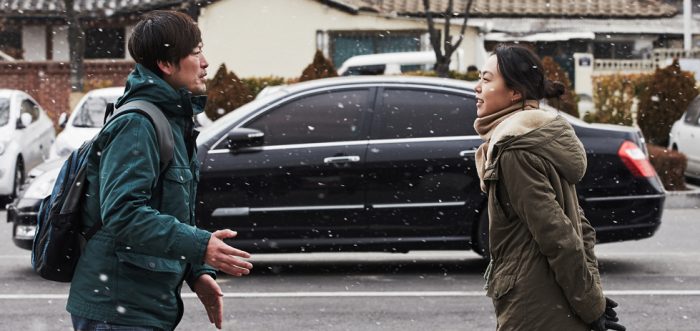
Bar a year here and there, Hong Sang-soo has released at least one film annually for his entire career.1 Hong has cut out a particularly unique space within Korean cinema, as a filmmaker obsessed with human interactions; often at their most awkward. Despite maintaining a relatively similar approach to filmmaking throughout his career, Hong’s films have always evoked particularly passionate responses – on both sides of the spectrum. Off the back of winning the Golden Leopard at Locarno – an award most recently bestowed to relatively experimental and left-field cinema.2 With this, Right Now, Wrong Then has emerged as both Hong’s most successful film since Our Sunhi (simultaneously, as a more critically lauded work), however, it’s also a deeply characteristic Hong film – and it’s far more likely to cement the divisive responses to the director’s work, rather than act as any sort of game-changer for his detractors.
Continuing a trend in Hong’s cinema of semi-autobiographical leads more than ever, Right Now, Wrong Then centres itself around a famous director named Han Chun-su (played by Our Sunhi star, Jung Jae-young) – he’s famous throughout the country, known for his work in “art cinema”; inspiring to his students, and exhausted with his critics. Hong’s characteristic hands-off directorial approach allows the strength of his cast to bring a more authentic chemistry to the stage.3
Both the story and the pacing of Right Now, Wrong Then shares a lot in common with his 2011 film The Day He Arrives – one that is similarly amongst the director’s most lauded works. The director as the protagonist, the use of a bar as a scene of dramatic shifts, and the emphasis on the presence of time are all again utilised in Right Now, Wrong Then. Whilst this emphasises Hong’s seemingly formulaic approach to filmmaking, it simultaneously reveals many of the strengths in his effort to push within these familiar boundaries through his latest work. While Hong’s trademark awkward camera zooms are still in the film, they feel more calculated than simply an aesthetic signature. They serve less as an ends of highlighting the awkwardness of human interaction, and more as a means to it; with Jung and Kim’s performances carrying the intimacy and delicacy of the relationships played out on screen.
All in all, Right Now, Wrong Then is one of Hong’s most masterful exercises in framing, as well as directing. The performances feel natural, convincing and evocative; yet comedic and silly – without being drowned out by Hong’s various stylistic watermarks and cliché. In the scene where Han Chun-su is getting worked up over a critic who he thought was being rude to him, he complains that “he’s shameless, ignorant and totally snobby”, with the self-effacing neurotic way in which Hong lets the rant carry out being a thinly-veiled piece of self-reflection. It might not paint the director in the best light but the honesty in its inclusion gives Right Now, Wrong Then‘s audience a window for empathy most films from Hong don’t offer to the same degree.
This greater sense of self-awareness suits the ambitions of Hong’s cinema, made particularly clear in the second half of the film, where the narrative repeats with slight variations. In the second take of the bar scene, Han declares “this feels awkward” followed by “I think I’m in love with you” and “I want to marry you” all within the same minute. This pointed dissection of social instincts, frame every interaction in the film. Yet, at two hours (one of the director’s longest films), this never feels exhausted or gimmicky. Comparisons with stories like Groundhog Day don’t give Right Now, Wrong Then credit as something less concerned with the novelty of repetition or change and more inclined to highlight the vicissitudes of human interaction, as well as the barriers that exist in our interactions and relationships. There’s still a great deal of corniness and cliché to Right Now, Wrong Then – and it’s the aspect that’s likely to keep the film as divisive as most of Hong’s back-catalogue. That said, the film does offer a wider palette of emotion, narrative, form, and insight than many of Hong’s recent works; and for audiences willing to navigate the director’s cinematic tendencies, the film has a lot to give.
